Exit 18 to the City Of Glens Falls, New York


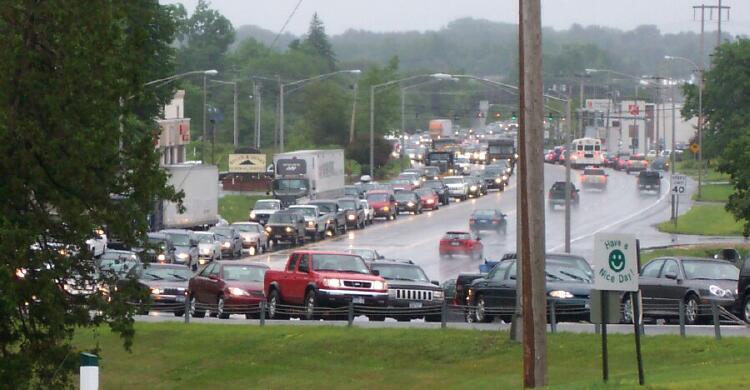

Above is the intersection of route 9 (going across the frame)
and NY 254 eastward (the road I'm on). This haneous traffic
resulted from the Northway closing between exit 18 and 19.
Again, no alternative non-surface street access to divert traffic.
It wouldn't be just an asset for situations like this, but for local
traffic.
In both these situations, cars were backed up so far that traffic
became backed up in the "box" of the intersection and turning lane traffic
could only clear the intersection at one car at a time. Cars turning
endured 15-20 minute waits just to clear the intersection.
Highly unacceptable.
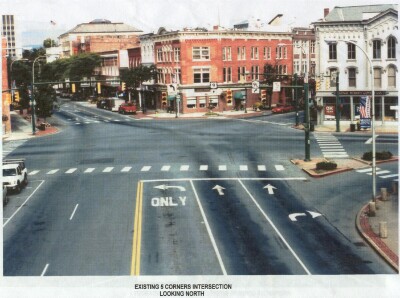

This all seems fine, except for one thing. Can anyone tell
me what those two men are doing in the "proposal" picture?!? | 
|
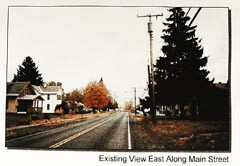
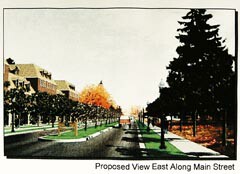
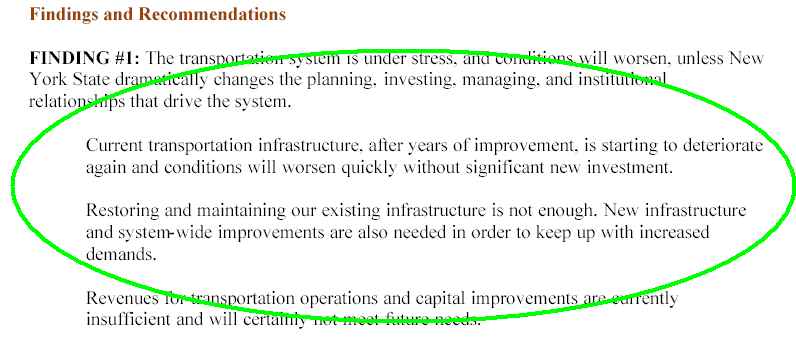
My letter to the editor, printed March 10, 2005:
I'm tired of reading about our area's wonderful prosperous future, complete with more big-box stores, pretty landscapes and sidewalks, round-a-bouts, additional turning lanes, and home and condo developments entering our community. All without one single mention, as usual, of addressing the need for adding additional capacity to our already overcrowded and failing infrastructure. If people cannot drive to, from, through, and around our city conveniently, then new development is not going to make people want to come here, because they will be leery of the traffic headaches that await them.
You can't push for development and not address that more cars on the roadways will result. It's like asking for a rain cloud and not wanting the rain that comes along with it. And don't give me the "more roads create more traffic" non-sense. "More reasons to drive here, and more people" is what creates more traffic - and that is exactly the direction our community is trying to go in. Putting in traffic circles and turning lanes does NOTHING to address additional vehicles on our roads, and is merely a band-aid that covers the wound at one intersection and moves the problem to others. In order for our community to grow and prosper, we must build new highways and facilitate traffic flow, not impede it, to, through and around our community. The bottom line is that our leaders are failing us by not taking our infrastructure's capacity into consideration within the scope of other development. Planning for current and future capacity, and building to truly accommodate growth will require a lot more than the closed-minded "round-a-bout" thinking that has plagued us for far too long.
|
Transportation Reauthorization - Get It Done!(This bill did pass August 2005 but with lots of pork stuffed into it) | ||

| Download AASHTO's latest Reauthorization brochure (PDF)More information about the American Association of State Highway and Transportation Offices can be found here on their web site. | 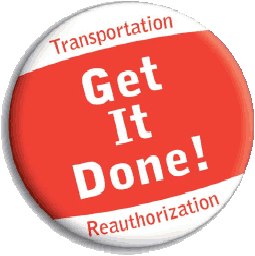
|
The Route 4 study, a draft released by the Adirondack/Glens Falls Transportation Council
regarding route 4 for Whitehall and Fort Anne; Washington County, made a profound statement
that I was questionning its justification of:
But, not everything stated in the above paragraph is true. Making a statement such as "that it is unrealistic to construct a new expressway from the Northway to the New York State/Vermont border" would seem preposterous and completely the opinion of the council... until you factor in why they have made this conclusion. This "unrealistic" solution is based on a cost-prohibitive analysis that takes a limited and set amount of short-term funding and finds ways to efficiently waste it on band-aids to the crippling infrastructure that do nothing to solve the long-term problems of highway growth and capacity, maintenance, and community prosperity. It's not the council's fault, they're just doing their job. This also shows a serious lack of foresight by our community leaders, and unfortunately presents a one-sided story to the general public. Improving existing conditions in developed areas is not the best long-term solution to improve traffic flow. So, what is? Reread the paragraph released by A/GFTC and then continue...
One statement is true: traffic volumes currently DON'T warrant widening the corridor because of the fact that this road is so poor in it's design that, despite the route's importance, travel is typically avoided. People just don't drive this route even though it is a vital link. This is a major highway corridor that has no supporting infrastructure. In today's economy, infrastructure means prosperity in so many ways. The addition of a major highway connecting Washington county and eastern Vermont to the interstate system will result in a drastic improvement in the quality of life, well-being, and economy for all residents and communities along its path. Current retail and manufacturing tax base in Washington county is almost non-existent, due to the county's deficiency along this corridor, and in general. Property taxes are through the roof as a result. Jefferson county is the only county in New York that is worse-off than Washington county for such a low amount of additional tax revenue, last I knew. How many major highways does Jefferson county have? Utilizing transportation corridors, on-demand retail distribution is shaping our world. TRIPNET.org reported recently that more than 80% of movable goods depend on road transport. Truck traffic for retail goods and manufacturing is at an all time high and shows no signs of slowing.
At an investment of a mere 300 million dollars, this option is actually rather inexpensive for a highway of this relatively short length, given the amount of mostly undeveloped land in the corridor's path.Financial price-tag aside, the amount of benefit to the county and region in tax revenue, increase in jobs and tourism, reduction of vehicle accidents, fatalities avoided, pollution reduced, travel time and wear and tear on vehicles reduced, and gas mileage increased will all far outweigh the expense, ESPECIALLY when factoring in how much it is really costing it's residents and users NOW by not having it. |
My letter to the editor, September 10, 2003:Road building not keeping up with needsPublished on 9/10/2003 Letters to the Editor THE POST-STAR Editor:Not once mentioned in any article regarding traffic deaths on route 149/4 is that the roadways had anything to do with these horrible and unfortunate accidents. If the road had been built as intended, countless lives wouldn't have come to a tragic end because of our lack of investment in infrastructure. Route 149 was widened for a couple of miles in Warren County. Fine improvements, but many years after they should've been done. Roadway capacity figures are determined decades in advance, and nothing is done when we have the opportunity to correct the problem before its a problem. Original plans for Route 149/4 were for an interstate highway to connect Glens Falls to Rutland, and eventually continue to Portland, Maine. Anyone who's driven to Rutland knows how nice it is to be greeted by the four-lane limited-access divided superhighway that Vermont built in anticipation for connection with its New York counterpart. And, the state of Vermont had to agree to reimburse New York 100 percent to build, in New York, a roadway connecting Route 7 to a bypass north of Bennington. Two miles of road are being built in New York on Vermont's dime. New York has isolated Rutland and Bennington from the interstate system, and in doing so deprived New Yorkers and New Englanders from greater accessibility. Apparently, getting cars conveniently into another state means moving revenue out of New York. New York's best interest is failing us. Regardless of why, our roads are still a problem. And even though most great highway plans in New York were scrapped, current progress has been at a snail's pace; not keeping up with increasingly higher traffic demands on our inadequate infrastructure every day. Route 149/4 could easily be upgraded to be four lanes and divided, or to include left or center turning lanes on a majority of its path. It's horrible to think that something as simple as turning lanes could have saved two lives last month. Even more frightening is how little it would have cost in comparison. Why do we continue to let our roadways fail us, not doing anything about it? Are people that blinded to the reality and importance of good highways and infrastructure that "not in my backyard" and aesthetics are more important than human lives? Population and traffic continue to rise, infrastructure is not keeping up. The roads are trying to tell us something.
|
I really appreciate feedback. Please leave your comments using this form. Thanks.
Robert Moses, one of the Fathers of Modern Highways, said this in 1954: Click here to hear it.
©2001 - 2012 Exit18.info, All Rights Reserved.